If something works, why not do it again?
Last year, Genesis launched the GV80 – the first mid-sized luxury crossover SUV to be offered by Hyundai’s luxury division – by using the bones (so to speak) of its G80 mid-sized luxury-sport sedan. This year, Hyundai’s luxury division has done the same thing, again – this time using the G70, its compact luxury-sport sedan, as the basis for the new GV70, its second luxury-sport crossover SUV.
Both aren’t the same things as so many other luxury crossovers – because neither of them are based on the bones of a front-wheel-drive car. They are both based on rear-wheel-drive cars – and that makes them handle and feel more like the rear-drive luxury-sport sedans they’re based upon.
What It Is
As per the above, the GV70 – italics on the V – is a new compact-sized luxury-sport crossover based on the G70 (no V) luxury-sport sedan. It has about the same overall footprint as its sport sedan progenitor, but offers much more cargo-carrying space and ground clearance – both aspects enhancing the practicality factor.
Interestingly – given the GV70 is only about an inch longer than the sedan it shares its bones with – it also has about three inches more rearseat legroom – which addresses the impracticality factor that besets compact sport sedans, which typically aren’t especially comfortable to ride in, if you have to ride in the back.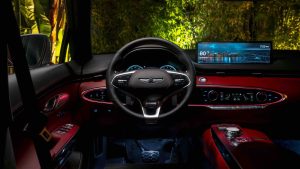
The GV70 also comes standard with a larger and much stronger engine than the G70 sedan – and is available with an even larger and stronger optional engine than is available in the G70.
Both of its engines are also paired with a full-time AWD system (Genesis markets this a 4WD, which it is – and isn’t – more on that below) which is optional in its sedan sibling.
Unsurprisingly, the GV70 is more expensive than the G70 – with a base price of $41,500 for the 2.5T trim vs. $37,775 for the G70.
A top-of-the-line GV70 3.5T stickers for $53,100.
What’s New for 2022
The GV70 is a brand-new model.
Standard engine is much more powerful (and no less fuel efficient) than the ones that come standard in several more expensive rivals, including the Mercedes-Benz GLC and BMW X3.
Rear-drive-based layout enhances balance and handling vs. front-drive-based rivals like the Acura RDX and Audi Q5.
A more practical iteration of the G70 sedan.
What’s Not So Good
Standard turbo four sounds like a four when you floor it.
Modest maximum tow rating (3,500 lbs.) even with the optional V6.
Rotary knob gear selector lacks connected feel; sometimes takes a moment to register you’ve selected Drive or Reverse.
Four cylinder engines – which used to be economy car engines – have become givens in vehicles with starting prices well over $40k – and even in many with starting prices over $50k, which used to get you at least a V6.
The good news is the 2.5 liter four that comes standard in the GV70 is as powerful as some of the V8s you used to get for this kind of money.
It makes 300 horsepower and 311 ft.-lbs. of torque at just 1,650 RPM.
Rivals such as the Mercedes-Benz GLC and BMW X3 also come with fours – but theirs only manage 255 and 248 horsepower, respectively. Interestingly, they don’t manage to use less gas. The GLC touts 22 city, 29 highway; the X3, 23 city, 29 highway. The Genesis matches them both, with a 22 city, 28 highway rating.
It also gets to 60 in about 5.6 seconds.
And you get AWD – standard. It’s optional in the GLC and X3, which cost substantially more when so equipped.
On the downside, you can’t get the Genesis without AWD. There’s more standard traction, of course. But it also means the GV costs more than it could have, had Genesis decided to offer it in a rear-drive variant. That would have served to further increase the already sizable price gap between itself and it’s pricier German rivals. It would also have reduced traction and so increased the fun – as of being able to let loose a burnout every now and then.
The GV’s optional engine is a 3.5 liter V6, twin-turbocharged, that makes 375 horsepower and 391 ft.-lbs. of torque at 1,300 RPM. This is output – of both horsepower and torque – that’s comparable to that of V8s without turbos.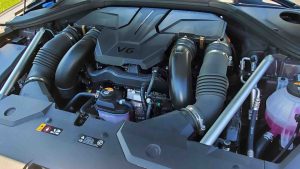
Equipped with this engine, the GV’s 0-60 time goes down to 4.9 seconds. That is nearly as quick as a ’90s-era Corvette ZR-1, the one with the exotic, Lotus-built four-cam V8 engine.
The GV70 would blow a standard-engined ’90s-era Corvette into the weeds.
Interestingly, gas mileage hardly goes down along with it. Despite being a larger engine – with two more cylinders and making 75 more horses – it rates 19 city/25 highway, a difference of about 2-3 MPG overall and so not a very noticeable difference.
An interesting difference – and lack thereof – arises when you compare the GV’s power-mileage stats with those of the BMW X3, when that one’s equipped with its optional 382 horse, 3.0 liter turbocharged six, which is also mildly hybridized. That means it has an electric car-like battery (just smaller) and motor to help reduce the amount of gas the BMW’s engine uses, by shutting it off as often as circumstances permit, as when stopped in traffic or coasting. But the end result is 21 city, 26 highway – essentially the same mileage as the Genesis achieves without the additional cost ($57,800 for the X3 M40i vs. $53,000 for the GV80 3.5T) or the additional complexity, which increases the odds of future costs.
The Benz GLC also offers a V6 – but without the mild-hybrid extras – that makes 385 horsepower, ten more than the GV’s V6 makes. But the Benz so equipped costs $59,900 – about $6k more than the GV with the V6.
Both Genesis engines are paired with eight speed automatics.
Oddly, the GV is only rated to pull a maximum of 3,500 lbs. It’s odd – because this rig has ample power and because it’s built around a rear drive layout, similar to that used in truck-based SUVs. The BMW X3 – which is similarly laid out – carries a 4,400 lb. maximum tow rating.
On the other hand, the Benz GLC is rated to pull no more than 3,500 lbs., even when it is equipped with its almost-400 horse V6.
The GV70 drives like the G70 it’s based on – only stronger. It has a near-50 horsepower advantage over the G70, which comes standard with a smaller (2.0 liter) four that only makes 252 horsepower.
If only it sounded stronger.
That is the chief failing – if it is one, as this is a subjective quality – of these very powerful but very small engines. The GV’s 2.5 liter engine develops about the same power-per-liter of displacement of a V8 more than twice its displacement. But it doesn’t produce the roar that only a V8 can make – and that’s an emotional loss, even if the power has been maintained. Of course, a V8 would also not be capable of approaching 30 MPG on the highway – as the GV’s four does – so there’s that as compensation. And given how much premium unleaded costs – courtesy of the Biden thing – that is not small compensation.
There’s another compensation, too.
The GV – equipped with its standard four – can travel almost 500 miles on the highway on 17 gallons of gas; even with the optional six, the GV’s highway range is still 435 miles. If it had a V8, you’d be stoping for more gas, sooner – costing you time and convenience.
Part of the reason for the GV’s impressive range is due to the really deep (0.565) overdrive gearing inside the eight speed automatic. At 65, it’s almost as if you’re coasting, with the engine turning little more than a fast idle, around 1,500 RPM. This is not just good for gas mileage. That engine speed coincides almost exactly with the engine speed at which peak torque is made. So even though the GV has an 8,000 RPM tach, it responds with the most forcefulness closer to idle speed.
And that makes up a lot for the sound that it doesn’t make.
There’s no mixed-bag about the GV’s handling, which is very much like the handling of its lower-to-the-ground G70 sibling. And that’s surprising. Or rather, testimony about the handling capabilities of crossovers that share much of their chassis and suspension underthings with high-performance sport sedans. This thing goes as straight in the curves as some go in the straights – and it can keep going on roads covered with snow, the bane of low-slung sport sedans, even when they have all-wheel-drive.
About that . . .
Genesis markets the system that the GV comes standard with as “4WD” – and that is a true description in that all four wheels are powered. But “4WD” has traditionally meant a part-time, truck-type system that usually operates in 2WD – with only the rear wheels powered, until 4WD is engaged.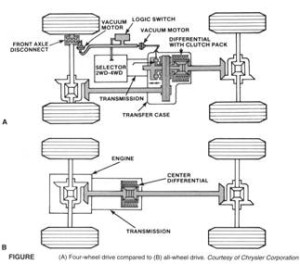
And – one more thing – there is usually a two-speed transfer case and 4WD Low range.
What the GV has is more akin to what others market as “AWD.” All four wheels receive power – all the time. The difference – as compared with most car-type AWD systems – is that most of the time, it is the rear wheels rather than the front wheels that receive the power. This imparts the feel of a rear-drive vehicle, especially under hard acceleration. A feeling that is enhanced by the rear-drive-based layout, which more equally spreads the weight of the engine/transmission/axle(s) over the length of the vehicle.
But there is no 4WD Low range gearing, which means this is not a “4×4” built to bully its way through deep, unplowed snow.
At The Curb
Why buy the GV70 over the less expensive G70? Aside from more standard engine – and standard “4WD”?
Because you get more standard room – and so, practicality. The latter being a quality that most sport sedans, however fun, often lack. They have tight back seats and even tinier trunks. The G70, for instance, has only 10.5 cubic feet of space in its trunk – vs. 28.9 cubic feet in the back of the GV70, behind the second row. When folded, the total space for cargo expands to 56.9 cubic feet, about five times the trunk space in the G70.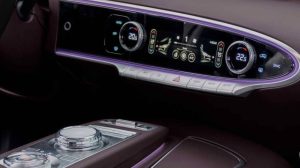
As far as backseat legroom, there’s a similar disparity – in favor of the GV70. It offers a much more passenger-friendly 37.2 inches of legroom, vs. 34.8 in the G70. These differences are pretty remarkable, given that the GV70 and G70 are about the same overall length, 185.6 inches and 184.4 inches, respectively.
The GV80 is also noticeably roomier – for both cargo and passengers – than the Mercedes-Benz GLC, which only has 19.4 cubic feet of space behind its second row, though it catches up with them folded (56.5 cubic feet). The BMW X3 matches the GV70 in terms of space behind its second row (28.7 cubic feet) and surpasses it (and the GLC) with its total available space of 62.7 cubic feet. But its back seats are just a touch less spacious, offering 36.4 inches of legroom.
The Rest
Genesis offers a plethora of options and upgrades for the GV70, including a form of keyless ignition that eliminates the need to carry even a key fob. Instead, you download an app and use your phone to unlock the door (and ignition). There is also an excellent, 16 speaker Lexicon sound system with huge bass speakers right under the seats – standard in the Sport 3.5T Advanced, which also comes standard with quilted leather seats. An electronic limited slip differential is included with the Sport Prestige package, which gets you heated second row seats, acoustic (sound dampening) rear side glass and a 12.3 inch digital display gauge cluster with 3D graphics.
But – arguably – the main thing that sells the GV relative to other compact-sized luxury crossovers is that you get more of those things, plus a lot of other things, for less than they cost in those other things – which lack some of the really important things, including respectably powerful standard engines.
This is the same formula Toyota used when it launched its now hugely successful Lexus line of luxury vehicles. Lexus snatched a lot of sales away from Benz and BMW.
Genesis is aiming to do the same.
The Bottom Line
Crossovers are popular because they are practical. So are washing machines. Here’s one that’s something more than that.
. . .
Got a question about cars, bikes or anything else? Click on the “ask Eric” link and send ’em in! Or email me directly at [email protected] if the @!** “ask Eric” button doesn’t work!
If you like what you’ve found here please consider supporting EPautos.
We depend on you to keep the wheels turning!
Our donate button is here.
If you prefer not to use PayPal, our mailing address is:
EPautos
721 Hummingbird Lane SE
Copper Hill, VA 24079
PS: Get an EPautos magnet or sticker or coaster in return for a $20 or more one-time donation or a $10 or more monthly recurring donation. (Please be sure to tell us you want a magnet or sticker or coaster – and also, provide an address, so we know where to mail the thing!)
My eBook about car buying (new and used) is also available for your favorite price – free! Click here. If that fails, email me at [email protected] and I will send you a copy directly!





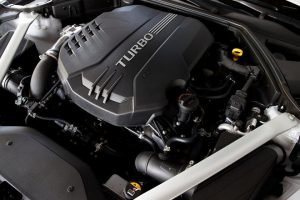

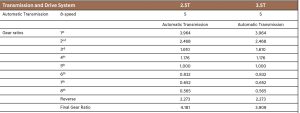








I’m curious to see what the real world fuel usage is. The problem with that advertised fuel economy number for the Genesis is the Hyundai/Kia propensity for falsifying their numbers (and being caught doing so). This is backed up by my own experience with a Kia Sedona that doesn’t even come close to it’s EPA rating. The Honda Odyssey which it replaced came much closer to its EPA rated fuel economy with the same driver.